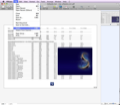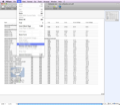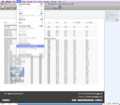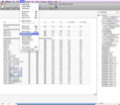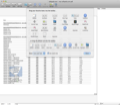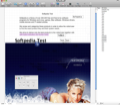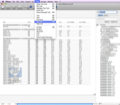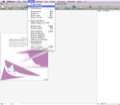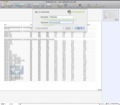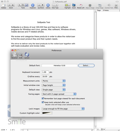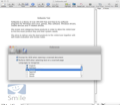One of the few inconveniences that users might encounter while working with PDF files might be that PDFs are read-only files. This is why, when it comes to editing PDF files, users have to, theoretically, convert them. PDFpen overcomes this problem, by providing users the possibility to make different types of corrections directly in their PDF docs.
PDF (Portable Document Format) is an open standard for document exchange. One of the reasons why users prefer PDF files is that they cannot be altered without leaving an electronic footprint.
Another reason why the PDF format is so popular might be the fact that the most utilized software for visualizing and printing PDF files (Adobe Acrobat Reader) is freeware.
Moreover, PDF files use, the so-called page description language. This language is used for describing the layout of printed pages. The pages can include text, images and objects.
In conclusion, the PDF format allows you to handle your documents in a secure and professional manner.
When it comes to editing PDFs you can, of course, use programs that convert read-only documents in other editable formats, but these conversions can be quite time-consuming.
To avoid the hurdle of having to convert any PDF file that you need to edit twice (once in an editable format and then back to PDF), you can use apps such as PDFpen. The main advantage of using PDFpen is that it lets you select and edit the text that you want to change in a text box, without asking you to convert the whole document.
In addition, PDFpen lets you add comments and notes into your files, the app can perform OCR on scanned documents, insert signatures, create libraries with your most used images, and much more.
The Look
The app's main window is pretty simple: it consists of a central area where you can load the document that you need to process, and of a customizable toolbar, displayed on the top of the window. In the main window, you can also see a sidebar which can include a table of contents or a list with search results, annotations and thumbnails. The information displayed in the sidebar will vary in accordance with the option selected from the View menu or from the sidebar's own pop-up menu.
The main toolbar includes by default a button for showing or hiding the sidebar, two navigation buttons (Up and Down), two zooming buttons (Zoom In/Out), as well as a drop-down for choosing the view type.
Moreover, the toolbar includes a group of three Tools buttons, a drop-down for choosing the highlighter's color, quick access buttons for the Inspector and the Library panels, a button for opening the area where you can make text corrections and an Insert button.
The Tools buttons give you access to three small pop-ups with selection tools, mark-up tools and, finally, drawing tools. The Selection Tools pop-up (marked with an arrow button) provides a text selection tool, as well as separate entries for actions such as edit, highlight or text scroll.t
The Markup Tools button (the second button in the Tools group of buttons) lets you quickly insert in the currently opened PDF file a text box, a note, a comment, a link to an external URL or even a link to another page.
The Drawing Tools button (the one with a scribble symbol on it) opens a pop-up with options for drawing a polygon, a rectangle, an ellipse or a line.
Unfortunately, the Tools buttons don't provide any tooltips. As a result, users who are not familiar with the interface have to click on every single button to see what it actually does. The images are not so straightforward and the buttons have no names attached to them.
Also, the role of the View Type control is confusing: even after you expand its associated drop-down list, you might have some problems understanding to what types of files the options refer to.
With regard to other customization options, you can add buttons for cropping or visually adjusting images, for rotating them to the left or to the right, for back and forward navigation, for print actions and more.
In conclusion, the interface is simple, clean and quite intuitive. Most of the buttons’ names are self-explanatory, but, as mentioned before, there are some exceptions to the rule: the Tools group of buttons and the View Type drop-down are just two of them.
The Works
To get started with PDFpen, you have to open a PDF file or an image from your disk. The main aim of the app is to let you easily edit PDF files, but, if you take the time to discover all its features, you will see that PDFpen can do much more than this.
One of its most valuable features lets you perform OCR (Optical Character Recognition) on scanned documents. Therefore, PDFpen allows you to convert any bitmap image into a piece of text, which can be selected, copied, or searched through. A big plus for the PDFpen app lays in the fact that it uses a very accurate OmniPage OCR engine.
Also, PDFpen lets you add, delete, combine or reorder pages. This comes in handy when you have to deal with PDF documents that include many pages. In such situations you can use PDFpen to shorten the long PDFs, in order to make a concise presentation out of them or even to send a summary of the pages via e-mail.
Furthermore, PDFpen enables you to perform different type of actions such as, selecting a certain area from a page, cropping an image or inserting a script into a selected PDF file.
The last type of action deserves a more careful look, because the extensive AppleScript support is considered to be one of PDFpen’s highlights. Here is why: by using scripts, users can automate many PDF manipulation processes, which can save them a lot of time.
To see the scripts included in the app click on the AppleScript icon, displayed to the right of the Help tab, in the main menu bar. At this step, please note that, the Combine and the Split PDFs scripts are implemented as droplets. If you want to combine or split folders directly from the Finder, you can copy these scripts to the Desktop.
Moreover, PDFpen lets you view the AppleScript dictionary by dragging the app onto the Script Editor icon and encourages you to write your own scripts. This means that, after playing with the scripts that are already included in PDFpen (Cover Fax Header, Export
Form Data, Imprint all Pages as First, Imprint all Pages with Image/ Text, etc.) you can try to create your own scripts and send them to PDFpen's developers. If the code is correct and the actions are considered to be relevant for the PDFpen app, you might see your script listed in the AppleScript tab.
Now, let us have a quick look at the common options. One of the most useful PDFpen tools is the editing tool. When using the Edit Tool you can replace and edit any piece of text in a selected PDF file by using editable text blocks.
This tool is very useful when you just need to edit a few words or paragraphs, and you don't want to lose too much time with a typical workflow (convert the PDF file into an editable format, make the changes and then convert it back to PDF).
In order to avoid such time-consuming actions, PDFpen provides a bunch of editing options in the Tools menu. By using these options you can, for instance, select a few lines from a paragraph and edit, highlight or even add a new piece of text, a comment, a note or a drawing, directly in the currently opened PDF file.
When it comes to processing pictures, PDFpen lets you resize, copy, crop and delete any type of image. Moreover, you can use PDFpen to overlay text and images. This feature comes in handy, when you want to add signatures to your files.
Here is how it works: first of all, you have to scan your signature and save it as an image file. Then, you have to insert it in your document and make it transparent by using the appropriate option in the Edit menu. To adjust the dimensions of your signature, you can keep the Shift key pressed and resize the margins of the signature image.
Furthermore, since you will probably want to use your scanned signature more than once, it is advisable to save it into the PDFpen Library. To do this, you have to open the Library panel, click on the plus button displayed on the bottom of the pop-up, and select the Add File option that appears in the context menu.
In this way, when you will want to add a signature in a PDF file, all you will have to do, will be to open the Library panel, select the signature image and choose the Add Selected Imprint option from the same context menu. You can also add signatures from the Library with drag-and-drop actions.
Another useful feature lets you reposition a group of elements. For this type of action you can either use the Inspector's Alignment tab or the Arrange tab in the main menu.
The Inspector pop-up can be opened from the main menu's Window tab and allows you to change some basic properties for a selected object (such as the margin's width for a box), align a group of objects, change the text or an object's background color and even assign some specific information (such as title, author or subject) to a document.
Finally, PDFpen lets you save documents to Evernote. Evernote is a cloud-based online service for saving and syncing a wide palette of information among a variety of platforms, including iPhone and iPad. In order to use Evernote Standard you need an online account.
The Evernote Standard account offers most of the features users usually need for managing notes and files. The fact that PDFpen provides Evernote access from the File menu is a great plus, since this feature allows you to save, manage and share your files safely and securely.
In conclusion, PDFpen is quite versatile and allows you to modify your PDF files in many different ways.
The Good
Another big plus lays in the fact that PDFpen uses the OCR technology. To be more exact, PDFpen provides its users a very accurate OmniPage OCR engine.
Moreover, PDFpen supports different types of editing actions. It lets you, easily select, highlight, or change a paragraph and it also enables you to add notes, comments of links to pages.
What I particularly like about PDFpen is that it helps you quickly sign PDF documents, by using the images saved in the PDF Library.
Last but not least, PDFpen offers AppleScript and Evernote support. Those two features enable you to create your own scripts and to easily share documents with your friends.
The Bad
The price of the demo version could make some of the users think twice before buying the full version of the PDFpen app.
The Truth
In addition to the fact that it lets you edit PDF files in different ways, PDFpen also provides you a lot of fancy features, such as Evernote integration or AppleScript support. Not to mention the fact that it uses the OCR technology beautifully.
The only thing that bothered me a little was the fact that the Tools buttons have no names. In conclusion, PDFpen is worth a try, especially if you prefer to save your documents and pictures in the PDF format and you use to edit them a lot.
 14 DAY TRIAL //
14 DAY TRIAL // 